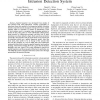Free Online Productivity Tools
i2Speak
i2Symbol
i2OCR
iTex2Img
iWeb2Print
iWeb2Shot
i2Type
iPdf2Split
iPdf2Merge
i2Bopomofo
i2Arabic
i2Style
i2Image
i2PDF
iLatex2Rtf
Sci2ools
HT
2005
ACM
2005
ACM
Information visualization for an intrusion detection system
— Spatial hypertext was developed from studies of how humans deal with information overflow particularly in situations where data needed to be interpreted quickly. Intrusion detection requires security managers of large networks to rapidly respond (often in real-time) to masses of information. Users of such systems need to recognize large developing patterns in masses of data, they prefer to work individually (although they must function in collaborative groups), and they rely on their intuitions more than deductive logic. Such users have particular personality characteristics and job needs which can be well served by interfaces which use a spatial hypertext model. Also, like most users, they prefer to be in charge of the process that they use the computer as a tool to assist with. The architecture proposed in this article is based on spatial hypertext and machine learning. That interface design allows for a great deal of interface flexibility and user control. The article discusse...
| Added | 26 Jun 2010 |
| Updated | 26 Jun 2010 |
| Type | Conference |
| Year | 2005 |
| Where | HT |
| Authors | James Blustein, Ching-Lung Fu, Daniel L. Silver |
Comments (0)

